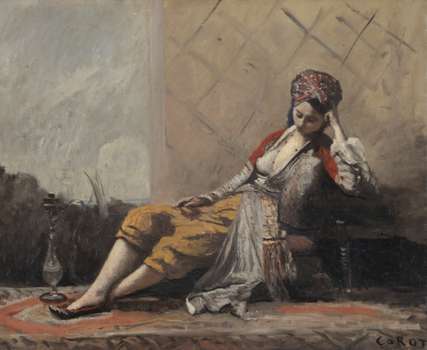Provenance research at Kunstmuseum St.Gallen
The permanent visibility of paintings even with disputed provenance is also to be ensured. The guidelines of the Washington Conference of 1998 regarding works of art confiscated by the National Socialists internationally regulate the tasks and duties of public museums in connection with looted works of art (looted art). The Kunstmuseum St. Gallen is as committed to the guidelines of the Washington Agreement as any other museum in Switzerland and, in this sense, also strongly advocates a just and fair settlement of claims.
Downloads (in German):
Zur Schenkung Dauberville / Nathan an das Kunstmuseum St.Gallen und das Kunstmuseum Basel
Zur Herkunft des Gemäldes Thunersee mit Stockhornkette von Ferdinand Hodler
Projects
Provenance research is a time-consuming and resource-intensive task. With support from the Federal Office of Culture (BAK) in Bern and the Lottery Fund of the Canton of St. Gallen, several projects have been successfully completed in recent years. The Kunstmuseum St. Gallen would like to thank the federal government and the canton for their ongoing help and looks forward to continuing this partnership in provenance research in the future.
Current Projects
The donation also includes 57 paintings, primarily from the Netherlands in the 17th century. This group of 57 works will be examined as part of the provenance research project in 2021 and 2022.
The processing of the works—which includes inventory, authentication, conservation, and provenance research—is both time-consuming and urgent, and the aim of this first research project is to make consistent progress on this task. Subsequent projects are being planned.
The Maria and Johannes Krüppel-Stärk donation represents a qualitatively and quantitatively significant new addition to the collection of the Kunstmuseum St. Gallen. The majority of the works were acquired from the German art market in the decades after the end of the war. Thus, there is an urgent need for specific research on the provenance of the works with a focus on the critical period of the Nazi regime between 1933 and 1945.
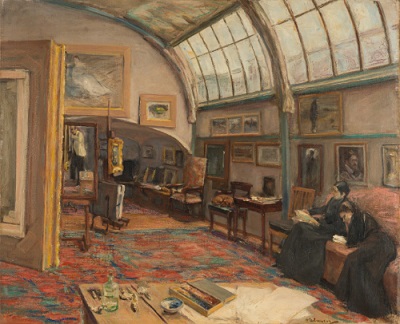
Works from the Ernst Schürpf Foundation at the Kunstmuseum St. Gallen
2021/2022 Research Project
Ernst Schürpf (1877–1939), who lived in St. Gallen, founded a textile company in his name in 1912, which produced and sold curtains and home textiles. He bequeathed a group of works by Dutch masters from the 17th century and French Realists from the 19th century to the Kunstmuseum St. Gallen, including paintings by Ostade, van der Werff, and Millet.
He also established the Ernst Schürpf Foundation, which has made it possible for the Kunstmuseum St. Gallen to purchase first-rate paintings from various eras since 1947. Acquisitions by the Ernst Schürpf Foundation include works by Anker, Böcklin, Le Corbusier, Corinth, Courbet, Delacroix, and Renoir, as well as Monet’s Palazzo Contarini and Liebermann’s The Artist’s Studio, which are particular highlights within the museum’s collection.
The Ernst Schürpf Foundation has donated a total of 55 works to the Kunstmuseum St. Gallen from different epochs extending up to the present day. Of the total of 55 works that are now at the Kunstmuseum St. Gallen thanks to the Ernst Schürpf Foundation, 24 were created before 1945 and were added to the collection after 1933. These works are the focus of the planned provenance research as part of the research project on the Ernst Schürpf Foundation. The donations from the Ernst Schürpf Foundation—in particular the first-rate group of works of French and German Impressionism—are of central importance to the collection of the Kunstmuseum St. Gallen and are among the core works in the permanent exhibition. In light of their importance for the museum as well as for international art history, researching and determining the provenance of the individual works is an urgent priority.
The Federal Office of Culture will support the project in 2021 and 2022.
Two extensive groups of works were stored in St. Gallen thanks to the personal involvement of the mayor at the time, Dr. Konrad Naegeli (1881–1951) with assistance from the German-Jewish art dealer Dr. Fritz Nathan (1895–1972). These were the collections of Gertrud and Alfred Sommerguth (1870–1954/1859–1950) from Berlin and Ilse and Robert Neumann (1887–1940/1875–1937) from Berlin and Merano. They included works by well-known artists such as Cézanne, Corinth, Cranach the Elder, Daumier, Friedrich, Hodler, Liebermann, Manet, Pissarro, and van Gogh. With a few exceptions, these works were brought out of storage and sold at the latest after the end of the war, and they are now scattered around the world. An extensive collection of files from the St. Gallen City Archives as well as documents from other archives enabled detailed research on the history of the works stored in St. Gallen. The findings from this research are not only significant for the history of the Kunstmuseum St. Gallen, but also of considerable relevance for provenance research in Switzerland and internationally.
The project was completed in autumn 2020, and the project report will be published here shortly.
Completed Projects
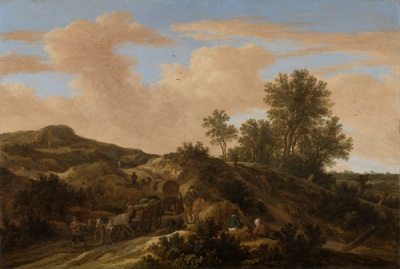
Paintings from the Maria and Johannes Krüppel-Stärk collection at the Kunstmuseum St. Gallen
The Canton of St. Gallen will continue to support provenance research at the Kunstmuseum St. Gallen in 2021 and 2022 as part of a clearly defined research project.
The Maria and Johannes Krüppel-Stärk collection was donated to the Kunstmuseum St. Gallen in 2018 and was presented to the public in a small, concentrated selection in the exhibition Old Master Stories in 2019 and 2020. In total the donation comprises 1504 works by old masters ranging from the 15th to 17th centuries, mainly works on paper of Dutch and in some cases early German origins.

Archive Project
The archive project supported by the Federal Office of Culture in 2019 and 2020 dealt with the groups of works stored in St. Gallen during the Nazi era: During this time, artworks from German, mostly Jewish collections were brought to various Swiss museums. There they were declared “unsaleable loans for exhibition purposes” and protected from confiscation by the Nazis.
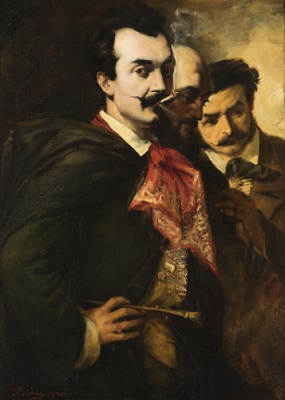
Sturzenegger Painting Collection (Lottery Fund Project)
In 2017 and 2018, the Kunstmuseum St. Gallen researched its holdings from the Sturzenegger Painting Collection with financial support from the Federal Office of Culture (BAK) (see “Completed Projects”).
In 1926, the embroidery manufacturer Eduard Sturzenegger (1854–1932) presented the city of St. Gallen with an extensive donation of works by German, Austrian, French, and Swiss artists, mostly from the 19th century. After 1935, this collection changed significantly due to sales and new acquisitions from the Swiss and international art market.
The project examined the provenance of the Sturzenegger Painting Collection, which now comprises 148 works at the Kunstmuseum St. Gallen. These include major works by Feuerbach, Corot, Sisley, and Pissarro, all of which were acquired after 1935. The state of research at the end of the project in 2018 did not show any inconsistencies in the documented provenance of any of the works in this collection. However, until a complete sequence of ownership between 1933 and the receipt of the collection has been determined, a problematic provenance cannot be completely ruled out for all works. For this reason, the Kunstmuseum St. Gallen realized a subsequent project in cooperation with the Cantonal Lottery Fund between 2018 and 2021.
This research deepened and expanded our knowledge about the provenances of the Sturzenegger Painting Collection, which is now part of the collection of the Kunstmuseum St. Gallen. The project also focused on Eduard Sturzenegger’s private collecting activities. Based on surviving documents, such as original invoices and an extensive archive of pictures, several hundred works were identified and the scope and characteristics of the private collection were traced. Only a minority of these works are part of the public collection in St. Gallen today. The insights from this research project are therefore of interest to the current owners as well as to researchers in Switzerland and abroad.
The report published here reflects the state of research in 2021.
Downloads (in German): Project report on the conclusion of the 2019–2021 provenance research project | Case studies | List of works
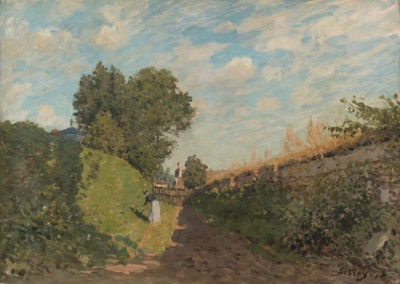
Works from the Estate of Emma Lina Hendel
In 2019 and 2020, the works from the Emma Lina Hendel bequest were examined in a project supported by the Federal Office of Culture (BAK). Emma Lina Hendel, a great-niece of the St. Gallen embroidery manufacturer Eduard Sturzenegger (whose collection was the focus of a project supported by the Cantonal Lottery Fund, which was completed in early 2021; see “Current projects”), bequeathed a group of 40 works from the 19th century to the Kunstmuseum St. Gallen in 1999.
Almost all of the 23 oil paintings as well as 17 drawings and prints were made by French artists. These include works by famous exponents of Romanticism, Realism, and Impressionism such as Corot, Daumier, Degas, Delacroix, Ingres, Monet, Renoir, Rodin, and Sisley. The research on the provenances had already started after the works were received in 1999, but it could not be adequately concluded at that time.
With the conclusion of the research project, progress has been made on this pending issue. No evidence of a problematic provenance was found for any of the works, and such a provenance was even ruled out entirely for eight works, including Monet’s Bras de Seine près de Vétheuil and Sisley’s Printemps à Saint-Germain-en-Laye.
The project report was approved by the Federal Office of Culture (BAK) in autumn 2020 and has been published on the website of the Kunstmuseum St. Gallen in consultation with the BAK.
Downloads (in German): Project report on the conclusion of the 2019–2020 provenance research project | Case studies | List of works
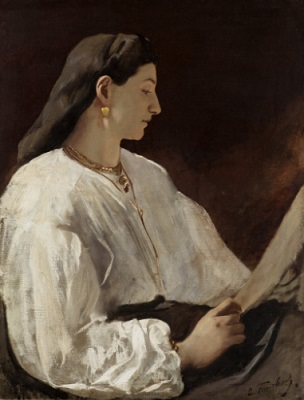
Sturzenegger Painting Collection (BAK Project)
The support from the Federal Office of Culture (BAK) enabled the Kunstmuseum St. Gallen to begin conducting provenance research in a clearly defined area of its collection in 2017: the works from the Sturzenegger Painting Collection. The project was completed in 2018 and the final report was approved by the BAK.
The research project did not reveal any concrete suspicion regarding the critical years of 1933 to 1945 for any of the works examined. The provenance of some of the most famous works in the collection, including Alfred Sisley’s Le Jardin (1873) and Anselm Feuerbach’s Nanna (1864/65), has been completely clarified upon verification of a seamless, unobjectionable succession of ownership during the Nazi regime. The comprehensive final report has been made available on the museum’s website in consultation with the BAK.
The report published here reflects the state of research in 2018.
Downloads (in German): Project report at the conclusion of the 2017–2018 provenance research project | Case studies | List of works
Swiss Working Group on Provenance Research
Scholars from all linguistic regions of Switzerland from museums, archives, and libraries as well as universities and art dealers have formed an association with the aim of exchanging information on provenance research in Switzerland and sharing their research findings across institutions in Switzerland and internationally.

